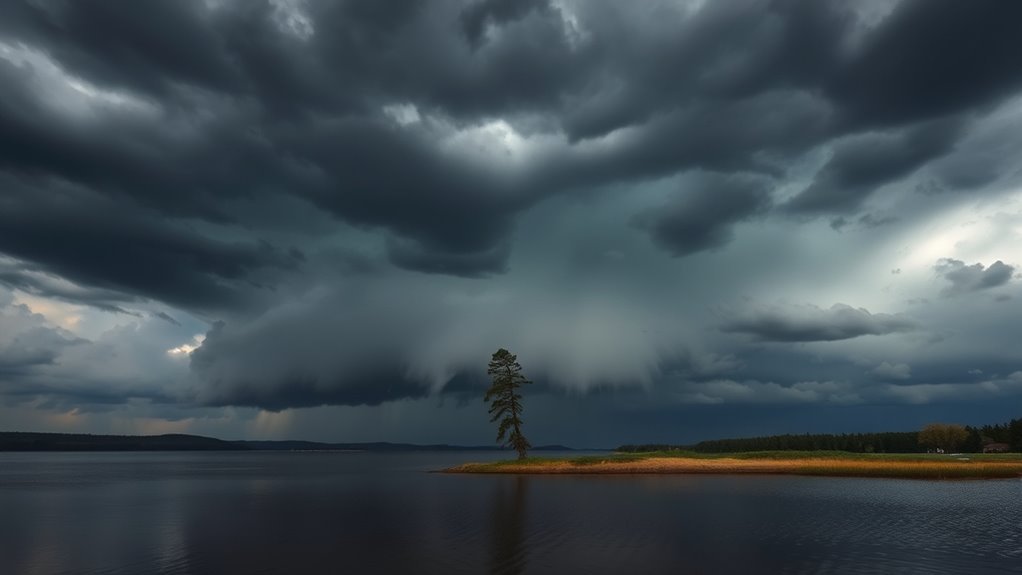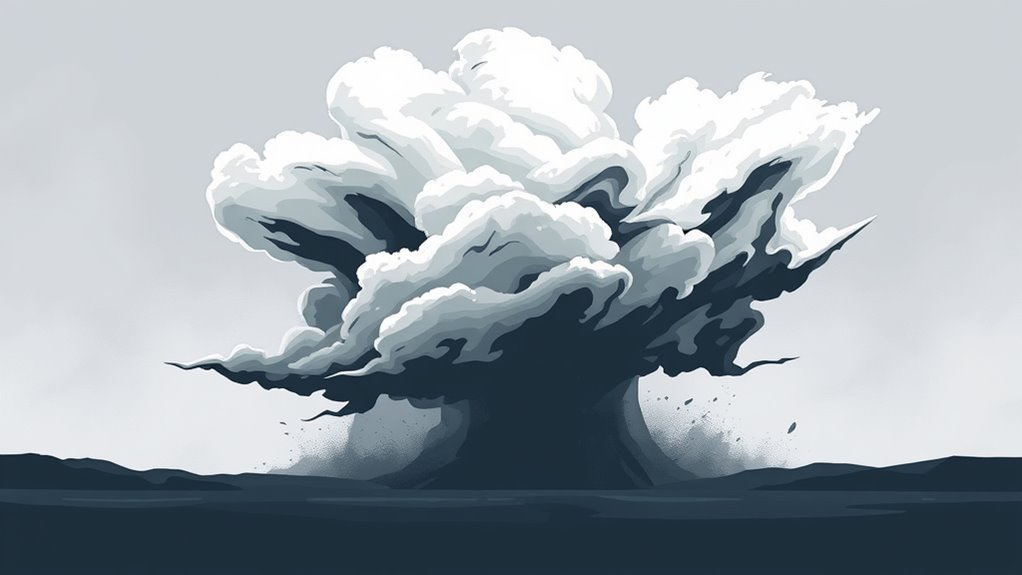Squalls are categorized into several types, each with distinct development processes. Thunderstorm squalls arise from warm, moist air colliding with cold fronts. Cold front squalls occur when cooler air forces warm air to ascend rapidly. Warm front squalls develop as warm air moves over cooler regions. Sea breezes trigger squalls along coastlines, creating instability. Additionally, microbursts are powerful downdrafts associated with squalls. Understanding these types is essential for safety and preparedness in unpredictable weather situations. There's more to investigate about their consequences.
Main Points
- Thunderstorm squalls form from warm, moist air rising rapidly when cold fronts collide with warm air masses, leading to severe weather changes.
- Cold front squalls occur when rapid cold air movement displaces warm air, causing abrupt weather shifts and increased wind speeds.
- Warm front squalls develop as warm air advances over cooler surfaces, marked by rising temperatures and sudden increases in wind speed and precipitation.
- Sea breeze squalls arise from land heating faster than the ocean, creating instability that can trigger thunderstorms as cooler sea air pushes inland.
- Each type of squall involves different atmospheric conditions, but all can lead to hazardous weather events and require careful monitoring.
Understanding Squalls: Definition and Characteristics
Squalls are sudden, intense bursts of wind that often accompany storms, greatly affecting weather conditions. Defined by a rapid increase in wind speed, squalls can change direction unexpectedly and bring turbulent conditions. They typically last from a few minutes to half an hour, leading to notable shifts in temperature and precipitation.
The nature of squalls can vary, with some being associated with cold fronts, while others may emerge from localized thunderstorms. The winds may reach speeds capable of creating hazardous situations, especially for marine and aviation activities.
Visibility can also diminish due to rain or blowing debris, further complicating conditions for those caught in a squall's path.
Understanding the features of squalls is essential for meteorologists and the general public alike, as timely warnings can mitigate risks and improve safety during severe weather events.
Thunderstorm Squalls: Formation and Impact

Thunderstorm squalls are defined by sudden, intense bursts of wind and precipitation that arise from specific atmospheric conditions.
Understanding the formation mechanisms behind these phenomena is essential for predicting their occurrence and impact on local weather patterns.
This discussion will investigate how these squalls develop and the notable effects they can have on surrounding environments.
Formation Mechanisms Explained
Weather phenomena such as thunderstorm squalls arise from specific atmospheric conditions that contribute to their formation and intensity.
These squalls typically develop when warm, moist air rises rapidly, creating a strong updraft. This process often occurs in environments defined by notable temperature contrasts, particularly when a cold front advances into a warm air mass.
The collision between these air masses causes instability, resulting in the rapid development of cumulus clouds and subsequent thunderstorms.
Additionally, the presence of wind shear, or changes in wind speed and direction with altitude, can improve the organization and strength of the squall line.
As these forces interact, they lead to the intense precipitation and gusty winds associated with thunderstorm squalls.
Impact on Weather Patterns
The formation of thunderstorm squalls greatly influences local and regional weather patterns. These phenomena can lead to sudden and severe weather changes, affecting both the environment and human activities.
Thunderstorm squalls typically bring intense rainfall, strong winds, and sometimes hail, which can cause considerable disruptions.
- Rapid temperature drops due to downdrafts
- Increased likelihood of flash flooding in vulnerable areas
- Improved risk of tornado formation within intense squall lines
- Impact on aviation through turbulence and reduced visibility
- Alteration of local ecosystems due to sudden precipitation events
Cold Front Squalls: How They Develop
Cold front squalls arise from the rapid movement of cold air masses that displace warmer, moist air.
This interaction leads to distinct weather characteristics, including abrupt wind shifts and sudden temperature drops.
Understanding the formation mechanism is essential to predicting the impacts of these squalls on local weather patterns.
Formation Mechanism Overview
As air masses interact, cold front squalls emerge through a specific formation mechanism that involves the rapid displacement of warm air by an advancing cold front.
This process typically occurs when a denser, colder air mass pushes into a warmer air mass, causing the warm air to rise quickly. The rising air cools and condenses, resulting in the formation of clouds and precipitation.
This dynamic interaction often leads to abrupt changes in weather conditions.
- Increased wind speeds due to pressure differences
- Sharp temperature gradients between air masses
- Rapid vertical motion of warm air
- Formation of cumulonimbus clouds
- Sudden and severe weather events, including thunderstorms
Weather Characteristics Explained
Squalls associated with cold fronts exhibit distinct weather characteristics marked by sudden changes in wind, temperature, and precipitation.
As a cold front approaches, there is typically a rapid increase in wind speed, often shifting from a southerly to a northwesterly direction. This shift can lead to intense gusts that precede the front's arrival.
Temperature drops sharply, often by several degrees within minutes. Precipitation associated with cold front squalls is usually heavy and may include thunderstorms, leading to brief but intense downpours.
The squall line can be accompanied by hail and lightning, adding to its severity. These abrupt weather changes contribute to the dynamic nature of cold front squalls, making them both notable and potentially hazardous phenomena in meteorology.
Warm Front Squalls: Characteristics and Behavior

When warm air masses advance over cooler surfaces, the resulting warm front squalls can create sudden and intense weather changes.
These squalls are marked by a rapid increase in wind speed, often accompanied by precipitation, which can vary from light rain to heavy downpours.
The changeover zone between warm and cool air is where these squalls typically develop, exhibiting unique behaviors that can impact local weather conditions greatly.
Key traits of warm front squalls include:
- Shift in Wind Direction: Winds typically shift from southeast to southwest.
- Temperature Change: A noticeable rise in temperatures follows the squall passage.
- Pressure Drop: Barometric pressure usually decreases before the squall and rises rapidly afterward.
- Cloud Formation: Thick cloud cover often precedes the squall, with cumulonimbus clouds prevalent.
- Visibility Reduction: Sudden decreases in visibility due to rainfall and wind.
Sea Breezes and Squalls: The Coastal Connection

While coastal areas experience a unique interplay between land and sea, sea breezes can lead to the formation of squalls that substantially alter local weather patterns.
These breezes arise when the land heats up faster than the ocean, causing cooler air from the sea to flow inland. As this cooler air pushes inland, it can lift the warmer air above it, creating instability in the atmosphere.
This instability may trigger rapid vertical development of clouds, often resulting in localized thunderstorms. The convergence of sea breezes from different directions can amplify this effect, leading to the formation of squalls distinguished by sudden gusts of wind and heavy rainfall.
These squalls can be intense but are often short-lived. Coastal communities must remain aware of the potential for sudden changes in weather brought about by these interactions, as they can meaningfully impact both daily activities and marine operations.
Microbursts: A Dangerous Type of Squall
The interaction of sea breezes can lead to various weather phenomena, one of the most hazardous being microbursts.
These localized downdrafts can occur during thunderstorms when cool air descends rapidly, creating severe wind gusts that can wreak havoc in their vicinity. Microbursts are particularly dangerous for aviation, as they can cause sudden changes in wind direction and intensity, posing risks during takeoff and landing.
Key characteristics of microbursts include:
- Rapid Wind Changes: Wind speeds can exceed 100 mph in a matter of seconds.
- Short Duration: Typically lasting only 5 to 15 minutes.
- Small Scale: Affected areas usually span less than 2.5 miles in diameter.
- Potential for Damage: Can uproot trees, damage structures, and create hazardous conditions.
- Difficult to Detect: Often elusive, making forecasting and warnings challenging.
Understanding microbursts is essential for mitigating their impact.
Safety Tips for Dealing With Squalls
Squalls can be unpredictable and intense, necessitating a proactive approach to safety. Individuals should always monitor weather forecasts and stay informed about potential squall warnings.
It is advisable to seek shelter indoors or in a sturdy vehicle when a squall is imminent. If outdoors, finding a low-lying area away from trees and structures can reduce the risk of injury from falling debris or sudden winds.
Boaters should avoid heading out during squall warnings and make sure vessels are equipped with proper safety gear. In the event of sudden wind shifts or heavy rain, securing loose items and steering into the waves can help maintain stability.
For those caught in a squall, it is essential to remain calm and avoid sudden movements. Awareness of surroundings and preparedness can considerably reduce risks associated with squalls, guaranteeing a safer experience during unpredictable weather conditions.
Common Questions
How Can Squalls Affect Air Travel Safety?
Squalls can markedly impact air travel safety by causing sudden gusts, reduced visibility, and turbulent conditions. Pilots must be alert to these rapid changes, as they can lead to dangerous flight maneuvers and potential accidents.
Are Squalls More Common in Certain Seasons?
Squalls exhibit seasonal variations, with their occurrence often peaking during specific times of the year. Typically, they are more frequent in spring and summer due to atmospheric instability and increased moisture in warmer temperatures.
What Are the Key Differences Between Squalls and Storms?
The key differences between squalls and storms lie in intensity and duration. Squalls are brief, intense bursts of wind and rain, while storms generally exhibit longer-lasting, more severe weather patterns, often accompanied by thunder and lightning.
Can Squalls Occur in Arid Regions?
Squalls can indeed occur in arid regions, although they are less common. These sudden bursts of wind and rain may arise from localized atmospheric disturbances, demonstrating that even dry climates can experience brief, intense weather events.
How Do Meteorologists Predict Squalls?
Meteorologists predict squalls by analyzing atmospheric conditions, including temperature changes, humidity levels, and wind patterns. Advanced radar technology and satellite imagery further improve their ability to detect and forecast these sudden weather phenomena effectively.

